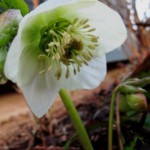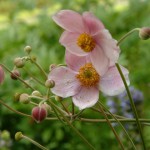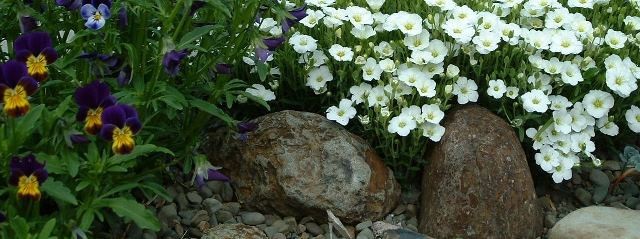 This is a picture of Helleborus niger, the Christmas Rose. Here in Delaware County, it might better be called the Easter Rose. It blooms later here because we have more severe winters. The Hellebore is in the Ranunculus family, or Ranunculaceae (botanists use the suffix –aceae to express a family relationship) and when you look at the flower structure inside the petals you can see the resemblance to an anemone’s structure (compare to the photo on the right). There are
This is a picture of Helleborus niger, the Christmas Rose. Here in Delaware County, it might better be called the Easter Rose. It blooms later here because we have more severe winters. The Hellebore is in the Ranunculus family, or Ranunculaceae (botanists use the suffix –aceae to express a family relationship) and when you look at the flower structure inside the petals you can see the resemblance to an anemone’s structure (compare to the photo on the right). There are  very many male parts (stamens) and they are clustered in a ring around the female parts in the center. The white “petals” of the Hellebore are actually the sepals. In most flowers, sepals serve as an envelope protecting the flower, and then once the flower is open, their job is done. In the Hellebore, the sepals function as petals, calling in the pollinators like white flags. The petals in the Hellebore have evolved to serve a different function. In the photo above you can see a ring of thick green scales between the sepals and the inner parts of the flower. These are the petals and they function as nectar-cups dispensing a reward to the pollinator.
very many male parts (stamens) and they are clustered in a ring around the female parts in the center. The white “petals” of the Hellebore are actually the sepals. In most flowers, sepals serve as an envelope protecting the flower, and then once the flower is open, their job is done. In the Hellebore, the sepals function as petals, calling in the pollinators like white flags. The petals in the Hellebore have evolved to serve a different function. In the photo above you can see a ring of thick green scales between the sepals and the inner parts of the flower. These are the petals and they function as nectar-cups dispensing a reward to the pollinator.
When they grow near humans they tend to be pollinated mostly by honeybees, but in the wild, they are visited during the morning hours mostly by small flies, but also by larger flies and wild types of bees.
In the wild, there are around 20 species of Helleborus. The hellebores are native to mixed woods in mountainous terrain from the German Alps in the west, and south down to the Dinaric Alps in Croatia. There is also a species on the Turkey-Syria border and a species in Tibet. They were separated from the European hellebores 23 million years ago, when Africa slammed into Eurasia and created the mountains from the Alps to the Himalayas.



